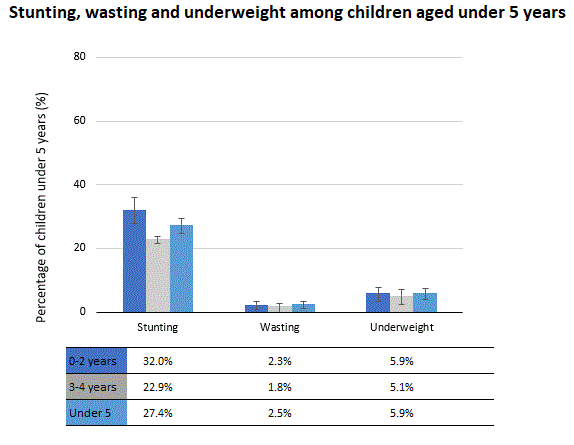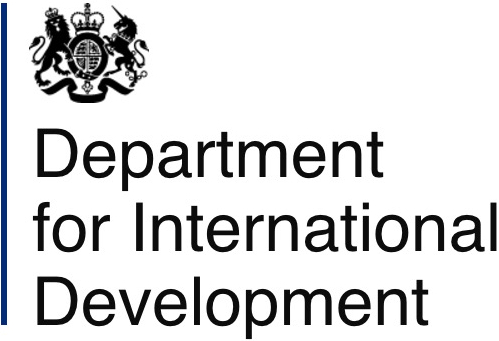Definition
Children who consume diets that are insufficient in energy and nutrients are at risk of undernutrition, which can manifest in the form of stunting, wasting, or underweight.
- Stunting occurs when a child’s height-for-age is low compared to healthy children in the same reference population. Stunting is a chronic form of malnutrition that manifests over a relatively long period of time compared to other forms of malnutrition.
- Wasting is an acute form of malnutrition and is present when the child’s weight-for-height is below the WHO reference point.
- Underweight is defined as low weight-for-age and occurs when child’s weight-for-age is below the WHO reference point.
Data

Notes
Source
Department of Health, Statistics South Africa, South African Medical Research Council and ICF (2017) South African Demographic & Health Survey 2016: Key Indicators. Pretoria and Rockville, Maryland: DOH, Stats SA, SAMRC & ICF. Analysis by Winnie Sambu.
What do the numbers tell us?
A child is classified as stunted, wasted or underweight if their height-for-age, weight-for-height, or weight-for-age scores respectively are more than two standard deviations below the globally accepted reference cut-off point as defined by the World Health Organization (WHO). Analysis of the 2016 South Africa Demographic and Health Survey (SADHS) shows that stunting is the most common manifestation of malnutrition in South Africa and affects 27% of children under five years old. Wasting and underweight rates for children under five are substantially lower, at 2.5% and 5.9% respectively.
The prevalence of stunting is higher among young boys (30%), than girls (25%). Rural areas have significantly higher stunting rates (29%) than urban areas (26%). Provincial estimates show that stunting is highest in the Free State and Gauteng (both at 34%), and lowest in Mpumalanga and Northern Cape provinces (both at 21%). However, it must be noted that the South African Demographic and Health Survey sample size is small and therefore the confidence intervals are wide when the data is disaggregated to lower levels, especially in provinces with small populations, like Northern Cape.
Maternal health is one of the most important predictors of child nutritional outcomes. Pregnant women who are undernourished are more likely to deliver babies with low birthweight who are in turn at risk of being stunted.1 Other maternal factors, such as education, can also affect a child’s nutritional status in that mothers with higher education levels are more likely than those without to make informed decisions around feeding and may make more regular visits to health care facilities during and after pregnancy.2 While 33% of children whose mothers do not have matric are stunted, the percentage among those whose mothers have at least a matric qualification is 17%.3
An important driver of stunting and other forms of malnutrition is the consumption of inadequate diets that are not sufficient in quantity and quality. In South Africa, only 23% of children aged 6 – 23 months were reported to have been fed a minimum acceptable diet that had minimum dietary diversity, meal frequency and appropriate milk feeds.4
Poverty is the main underlying cause of undernutrition, leading to more direct causes of poor nutritional status. Hunger and low dietary diversity are more prevalent in poor households. Similarly, inadequate living conditions such as inadequate water and sanitation, are more common among poor households. These conditions can cause children to suffer from infections like diarrhoea and pneumonia, increasing the risk of them becoming wasted. If these infections occur frequently or become severe, they can result in more chronic forms of malnutrition.5 Under-five stunting rates are highest in the poorest wealth quintile (36%), and lowest in the richest quintile (13%).6
Undernutrition rates are higher among young children particularly those in the first 1,000 days of life. This is mainly because early childhood is a period of rapid growth and development and inadequate dietary intake can easily compromise this process. During this stage, children are also prone to illness due to poor feeding or exposure to poor living conditions in the home and environment. A third of children aged 0 – 2 years are stunted, compared to nearly a quarter for children aged 3 – 4 years.
Undernutrition increases the risk of infection in early childhood, which in turn compromises the child’s health and increases healthcare costs for the child’s household and government. Undernutrition is an underlying cause of mortality in children. An audit of hospital child deaths in South Africa found that 30% of infants (28 days – 1 year) and 42% of 1 – 5-year olds who died in 2012/13 were severely malnourished (suffering from Kwashiorkor, Marasmus, or Marasmic Kwashiorkor).7 Of those who died from diarrhoeal causes, almost 40% were severely malnourished.8
Older children who are undernourished are more likely to be absent from school, and this compromises their learning. In addition, malnutrition is a risk factor for poor child development, with various studies showing associations between stunting and poor motor and cognitive development.9 The effects of malnutrition also extend to adulthood, where productivity has been shown to be significantly affected.10 It can be difficult for children who are stunted to recover, and for those who do, the negative effects experienced while stunted (such as poor cognitive development), may be irreversible.11
1 Danaei G, Andrews GK,Sudfeld RC,Fink G, McCoy DC, Peet E, Sania A, Fawzi MCS, Ezzati M & Fawzi WW (2016) Risk factors for childhood stunting in 137 developing countries: a comparative risk assessment analysis at global, regional, and country levels. PLoS Medicine, 13(11): 1-18;
Richter L M, Orkin FM, Roman GD, Dahly DL, Horta BL, Bhargava SK, Norris SA & Stein AD (2018) Comparative models of biological and social pathways to predict child growth through age 2 years from birth cohorts in Brazil, India, the Philippines, and South Africa’, Journal of Nutrition, 148(8): 1364–1371..
2 Casale D & Desmond C (2016) Recovery from stunting and cognitive outcomes in young children: Evidence from the South African Birth to Twenty Cohort Study. Journal of Developmental Origins of Health and Disease, 7(2): 163-171.
3 Department of Health, Statistics South Africa, South African Medical Research Council and ICF (2017) South African Demographic & Health Survey 2016: Key Indicators. Pretoria and Rockville, Maryland: DOH, Stats SA, SAMRC & ICF. Analysis by Winnie Sambu.
4 Department of Health et al (2017) above.
5 Black RE, Victora CG, Walker SP, Bhutta ZA, Christian P, De Onis M, Ezzati M, Grantham-Mcgregor S, Katz J, Martorell R & Uauy R (2013) Maternal and child undernutrition and overweight in low-income and middle-income countries. The Lancet, 382(9890): 427-451
Danaei et al (2016), above.
6 South African Demographic & Health Survey 2016. Analysis by Winnie Sambu.
7 Harper K (2016) An overview of child PIP national data 2012 – 2013. In: Stephen CR (2016) Saving Children 2012 – 2013: An eighth survey of child healthcare in South Africa. Pretoria: Tshepesa Press, Medical Research Council, CDC.
8 Harper (2016), above.
9 Grantham-McGregor S, Cheung YB, Cueto S, Glewwe P, Richter L & Strupp B (2007) Developmental potential in the first five years for children in developing countries. The Lancet, 369(9555): 60-70;
Walker SP, Wachs TD, Grantham-Mcgregor S, Black MM, Nelson CA, Huffman SL, Baker-Henningham H, Chang, SM, Hamadani JD, Lozoff B, Gardner JMM, Powell CA, Rahman A & Richter L (2011) Inequality in early childhood: Risk and protective factors for early child development. The Lancet, 378(9799): 1325-1338;
Walker SP,Chang SM, Wright A, Osmond C, & Grantham-McGregor SM. (2015) Early childhood stunting is associated with lower developmental levels in the subsequent generation of children. Journal of Nutrition, 145(4): 823-828.
10 Hoddinott J, Alderman H, Behrman JR, Haddad L, Horton S (2013) The economic rationale for investing in stunting reduction. Maternal and Child Nutrition, 9(S2): 69-82.
11 Casale & Desmond,(2016), above.
The prevalence of stunting is higher among young boys (30%), than girls (25%). Rural areas have significantly higher stunting rates (29%) than urban areas (26%). Provincial estimates show that stunting is highest in the Free State and Gauteng (both at 34%), and lowest in Mpumalanga and Northern Cape provinces (both at 21%). However, it must be noted that the South African Demographic and Health Survey sample size is small and therefore the confidence intervals are wide when the data is disaggregated to lower levels, especially in provinces with small populations, like Northern Cape.
Maternal health is one of the most important predictors of child nutritional outcomes. Pregnant women who are undernourished are more likely to deliver babies with low birthweight who are in turn at risk of being stunted.1 Other maternal factors, such as education, can also affect a child’s nutritional status in that mothers with higher education levels are more likely than those without to make informed decisions around feeding and may make more regular visits to health care facilities during and after pregnancy.2 While 33% of children whose mothers do not have matric are stunted, the percentage among those whose mothers have at least a matric qualification is 17%.3
An important driver of stunting and other forms of malnutrition is the consumption of inadequate diets that are not sufficient in quantity and quality. In South Africa, only 23% of children aged 6 – 23 months were reported to have been fed a minimum acceptable diet that had minimum dietary diversity, meal frequency and appropriate milk feeds.4
Poverty is the main underlying cause of undernutrition, leading to more direct causes of poor nutritional status. Hunger and low dietary diversity are more prevalent in poor households. Similarly, inadequate living conditions such as inadequate water and sanitation, are more common among poor households. These conditions can cause children to suffer from infections like diarrhoea and pneumonia, increasing the risk of them becoming wasted. If these infections occur frequently or become severe, they can result in more chronic forms of malnutrition.5 Under-five stunting rates are highest in the poorest wealth quintile (36%), and lowest in the richest quintile (13%).6
Undernutrition rates are higher among young children particularly those in the first 1,000 days of life. This is mainly because early childhood is a period of rapid growth and development and inadequate dietary intake can easily compromise this process. During this stage, children are also prone to illness due to poor feeding or exposure to poor living conditions in the home and environment. A third of children aged 0 – 2 years are stunted, compared to nearly a quarter for children aged 3 – 4 years.
Undernutrition increases the risk of infection in early childhood, which in turn compromises the child’s health and increases healthcare costs for the child’s household and government. Undernutrition is an underlying cause of mortality in children. An audit of hospital child deaths in South Africa found that 30% of infants (28 days – 1 year) and 42% of 1 – 5-year olds who died in 2012/13 were severely malnourished (suffering from Kwashiorkor, Marasmus, or Marasmic Kwashiorkor).7 Of those who died from diarrhoeal causes, almost 40% were severely malnourished.8
Older children who are undernourished are more likely to be absent from school, and this compromises their learning. In addition, malnutrition is a risk factor for poor child development, with various studies showing associations between stunting and poor motor and cognitive development.9 The effects of malnutrition also extend to adulthood, where productivity has been shown to be significantly affected.10 It can be difficult for children who are stunted to recover, and for those who do, the negative effects experienced while stunted (such as poor cognitive development), may be irreversible.11
1 Danaei G, Andrews GK,Sudfeld RC,Fink G, McCoy DC, Peet E, Sania A, Fawzi MCS, Ezzati M & Fawzi WW (2016) Risk factors for childhood stunting in 137 developing countries: a comparative risk assessment analysis at global, regional, and country levels. PLoS Medicine, 13(11): 1-18;
Richter L M, Orkin FM, Roman GD, Dahly DL, Horta BL, Bhargava SK, Norris SA & Stein AD (2018) Comparative models of biological and social pathways to predict child growth through age 2 years from birth cohorts in Brazil, India, the Philippines, and South Africa’, Journal of Nutrition, 148(8): 1364–1371..
2 Casale D & Desmond C (2016) Recovery from stunting and cognitive outcomes in young children: Evidence from the South African Birth to Twenty Cohort Study. Journal of Developmental Origins of Health and Disease, 7(2): 163-171.
3 Department of Health, Statistics South Africa, South African Medical Research Council and ICF (2017) South African Demographic & Health Survey 2016: Key Indicators. Pretoria and Rockville, Maryland: DOH, Stats SA, SAMRC & ICF. Analysis by Winnie Sambu.
4 Department of Health et al (2017) above.
5 Black RE, Victora CG, Walker SP, Bhutta ZA, Christian P, De Onis M, Ezzati M, Grantham-Mcgregor S, Katz J, Martorell R & Uauy R (2013) Maternal and child undernutrition and overweight in low-income and middle-income countries. The Lancet, 382(9890): 427-451
Danaei et al (2016), above.
6 South African Demographic & Health Survey 2016. Analysis by Winnie Sambu.
7 Harper K (2016) An overview of child PIP national data 2012 – 2013. In: Stephen CR (2016) Saving Children 2012 – 2013: An eighth survey of child healthcare in South Africa. Pretoria: Tshepesa Press, Medical Research Council, CDC.
8 Harper (2016), above.
9 Grantham-McGregor S, Cheung YB, Cueto S, Glewwe P, Richter L & Strupp B (2007) Developmental potential in the first five years for children in developing countries. The Lancet, 369(9555): 60-70;
Walker SP, Wachs TD, Grantham-Mcgregor S, Black MM, Nelson CA, Huffman SL, Baker-Henningham H, Chang, SM, Hamadani JD, Lozoff B, Gardner JMM, Powell CA, Rahman A & Richter L (2011) Inequality in early childhood: Risk and protective factors for early child development. The Lancet, 378(9799): 1325-1338;
Walker SP,Chang SM, Wright A, Osmond C, & Grantham-McGregor SM. (2015) Early childhood stunting is associated with lower developmental levels in the subsequent generation of children. Journal of Nutrition, 145(4): 823-828.
10 Hoddinott J, Alderman H, Behrman JR, Haddad L, Horton S (2013) The economic rationale for investing in stunting reduction. Maternal and Child Nutrition, 9(S2): 69-82.
11 Casale & Desmond,(2016), above.






 The SAECR 2024 tracks trends on the status of children under 6.
The SAECR 2024 tracks trends on the status of children under 6. 








